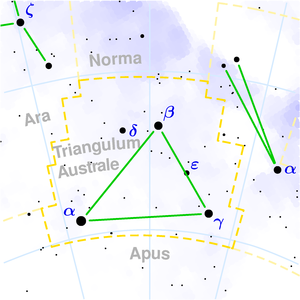Southern triangle
|
Southern Triangle constellation |
|
|---|---|
| Latin name | Triangulum Australe |
| Latin genitive | Trianguli Australis |
| Abbreviation | TrA |
| Right ascension | 14 h 56 m 01 s to 17 h 13 m 53 s |
| declination | −70 ° 30 ′ 42 ″ to −60 ° 15 ′ 52 ″ |
| surface | 109.978 deg² rank 83 |
| Completely visible | 19.3 ° N to 90 ° S |
| Observation time for Central Europe | not observable |
| Number of stars brighter than 3 mag | 3 |
| Brightest star (size) | Atria (1.91) |
| Meteor streams | |
|
Neighboring constellations ( clockwise from north ) |
|
| swell | IAU , |
 The Triangulum Australe constellation as seen with the naked eye |
|
The Southern Triangle ( Latin Triangulum Australe ) is a constellation in the southern sky.
description
The constellation is composed of three bright stars . It is more noticeable than its northern counterpart, the triangle .
The ribbon of the Milky Way runs through the southern triangle . Here you can find the striking open star cluster NGC 6025 .
The Southern Triangle is invisible from Central Europe . Correct observation is only possible south of the Tropic of Capricorn.
history
The Dutch navigators Pieter Dirkszoon Keyser and Frederick de Houtman , who measured the southern sky from 1595–97, are sometimes named as the originators of the constellation . It was taken from them by Johann Bayer in his Sky Atlas Uranometria , published in 1603 , and he is also given as the author due to the decisive importance of his work. As early as 1589, however, it was found on a celestial globe by Petrus Plancius . In fact, it is there, but on the head, and only on the globe of 1598 which converts the measurement of Keyser and de Houtman, it is presented properly. Described it was as early as 1500 by the Spanish navigator Mestre João , the Italian explorer Amerigo Vespucci mentions it can be found in the report of his second trip in 1502, and it is also found in Andreas Corsali (1512). Plancius is likely to have referred to the reports of the latter two, but to have had no precise positions.
Celestial objects
Stars
| B. | F. | Names or other designations | m | Lj | Spectral class |
|---|---|---|---|---|---|
| α | Atria | 1.91 | 416 | K2 IIb-IIIa | |
| β | Betria | 2.83 | 40 | F2 III | |
| γ | Gatria | 2.87 | 183 | A1 V | |
| δ | 3.86 | 621 | G5 II | ||
| ε | 4.11 | 216 | K0 III | ||
| ζ | 4.90 | 39 | F9 V | ||
| LP | 5.10 | 626 | Ap | ||
| κ | 5.11 | 3000 | G6 VII | ||
| HR 6125 | 5.19 | 670 | K0 II / IIICN | ||
| ι | 5.28 | 132 | F4 IV | ||
| θ | 5.50 | 328 | G8 / K0 III | ||
| η | 5.89 |
The brightest star, α Trianguli Australis, is 416 light years away. It is an orange shining star of the spectral class K2, with nine times the mass and 2,000 times the luminosity of our sun .
The name Atria is an abbreviation for A lpha Tr ianguli A ustrale.
β Trianguli Australis, the second brightest star, is 40 light-years away from the sun.
Variable stars
| star | m | period | Type |
|---|---|---|---|
| ι | 5.3 | Gamma Doradus changer | |
| R. | 6.0 to 6.8 | 3.4 days | Cepheid |
ι Trianguli Australis is a variable star of the type Gamma Doradus, 132 light years away .
R Trianguli Australis is a pulsation-variable star of the Cepheid type . Its brightness changes regularly over a period of 3.4 days.
NGC objects
| Messier (M) | NGC | other | m | Type | Surname |
|---|---|---|---|---|---|
| 5844 | Planetary nebula | ||||
| 5979 | Planetary nebula | ||||
| 6025 | 5.1 | Open star cluster | |||
| 6156 | Galaxy | ||||
| IC 4584 | Galaxy | ||||
| IC 4585 | Galaxy | ||||
| IC 4595 | Galaxy |
6025 is an open star cluster about 2,700 light years away. It contains about 60 stars that are brighter than the 7th magnitude. Even in prism binoculars , it is a beautiful sight.
See also
Individual evidence
- ↑ Jim Fuchs: Filling the Sky. 2003, ISBN 0-9744397-1-1 ; Chapter Triangulum Australe. P. 79 as a web document ( memento of the original dated August 28, 2008 in the Internet Archive ) Info: The archive link was inserted automatically and has not yet been checked. Please check the original and archive link according to the instructions and then remove this notice. , PDF 0.2 MB
